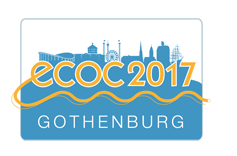WORKSHOPS
Constellation shaping – a simple add-on or a tool to combat the nonlinear fiber limit?
Sunday 09.00-13:00
Organisers:
Metodi P. Yankov, Technical University of Denmark, Denmark
Erik Agrell, Chalmers University of Technology, Sweden
Abstract:
Constellation shaping has in recent years gathered popularity as a tool for extending the reach of coherent optical communication systems. Particularly, probabilistic shaping has been shown to be beneficial for systems, operating at high-order QAM (beyond 16QAM). Current practical constellation shaping methods allow for 10-20% data rate/reach increase mostly due to their tolerance to the white Gaussian noise originating from amplification. However, such constellations are generally intolerant to nonlinear noise and are thus limited to operating in the weakly nonlinear region.
Constellation constructions which are tolerant to nonlinearities, and at the same time provide high spectral efficiency and can be implemented with reasonable complexity in order to support very high-speed optical communications are as of yet unavailable.
This workshop aims at providing a forum for discussion between leading scientists in the field, with a focus on constellation shaping for the nonlinear region of transmission. We will review currently popular constellation shaping methods and discuss different aspects of their implementation, scalability, integrability with existing systems, and potential gains that they provide. Important aspect of the discussion will be whether these schemes and their gains can be extended into the nonlinear region, or completely new solutions are required in order to drastically improve the system performance.
The workshop will include, but is not limited to the following discussion topics:
- Practical implementation in current state-of-the-art transceivers and systems—what are the requirements for the transceiver architecture and protocols?
- How does shaping fit with other popular nonlinearity mitigation/compensation techniques, such as digital back-propagation, optical phase-conjugation, and sub-carrier multiplexing? Are they complementary or competitive?
- What is a “nonlinearity tolerant constellation”?
- Geometric vs. probabilistic shaping—is joint optimisation beneficial/feasible, or is either sufficient independently? What are the tradeoffs?
- Are we limited to the weakly nonlinear regime, or are there benefits from operating in the nonlinear regime?
- Shaping for SDM systems—are there gains, and are they worth the effort?
- Shaping for short-reach noncoherent communication—is that feasible?
Workshop structure
Session 1: Theoretical aspects of shaping: Nonlinearity mitigation and power efficiency
9:00 – Session I opening
9:05 – Georg Böcherer, Technical University of Munich, Germany, “Probabilistic, geometric, X-dimensional, X-ary: The probabilistic amplitude shaping Swiss army knife”, by Georg Böcherer, Patrick Schulte and Fabian Steiner.
9:15 – Marco Secondini, School of Advanced Studies, Sant’Anna, Pisa, Italy, “Possible approaches to design a nonlinearity-tolerant constellation”, by Marco Secondini.
9:25 – Tobias Fehenberger, Technical University of Munich, Germany, “On the limits of per-symbol probabilistic shaping in optical fiber communications”, by Tobias Fehenberger.
9:35 – Ivan Djordjevic, University of Arizona, Tucson, Arizona, U.S.A., “Exploring the non-uniform shaped modulation formats”, by Zhen Qu and Ivan B. Djordjevic.
9:45 – Hartmut Hafermann, Huawei Technologies, France, “Nonlinearity-tolerant high-dimensional modulation formats”, by Hartmut Hafermann.
9:55 – Mariia Sorokina, Aston University, Birmingham, U.K., “Ripple distribution for nonlinear fiber-optic channels”, by Mariia Sorokina, Stylianos Sygletos, and Sergei Turitsyn.
10:05-10:50 – Open mic & panel discussion
10:50-11:10 – coffee break
Session 2: Practical aspects and applications of constellation shaping
11:10 – Session II opening
11:15 – Toshiaki Koike-Akino, Mitsubishi Electric Research Laboratories, Cambridge, Massachusetts, U.S.A., “Constellation shaping: hypes versus reality”, by Toshiaki Koike-Akino, David S. Millar, Keisuke Kojima, and Kieran Parsons.
11:25 – Olga Vassilieva, Fujitsu Laboratories of America, Inc., “Is it an ultimate technology and what is the application area”, by Olga Vassilieva, Inwoong Kim and Tadashi Ikeuchi.
11:35 – Alexandre Graell i Amat, Chalmers University of Technology, Gothenburg, Sweden, “Probabilistic shaping and hard-decision decoding: can we close the gap with soft-decision decoding?”, by Alexandre Graell i Amat
11:45 – Fred Buchali, Nokia Bell Labs, Stuttgart, Germany, “Experimental proof of probabilistic shaping”, by Fred Buchali.
11:55 – Xiang Zhou, Google Inc., U.S.A. “Constellation shaping: can it be useful for short reach communication?”, by Xiang Zhou and Hong Liu.
12:05 – Stephen Grubb, Facebook, Menlo Park, California, U.S.A., “The applications of PCS in submarine and long haul optical networks”, by Stephen Grubb
12:15-13:00 – Open mic & panel discussion

